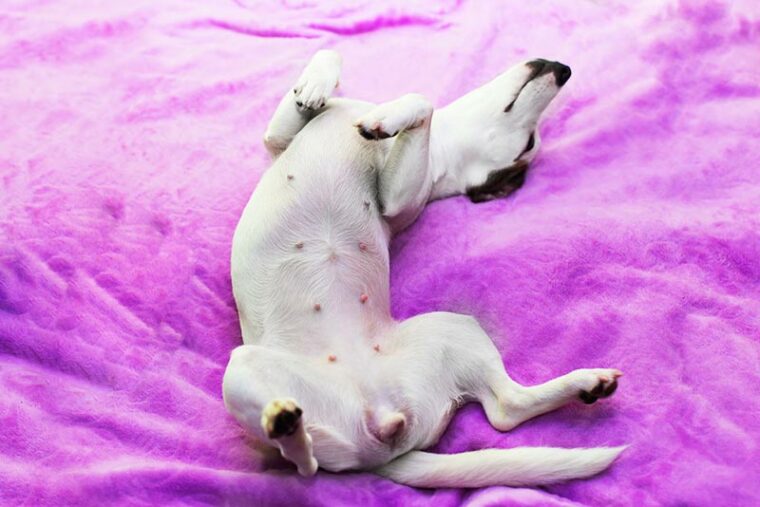- August 2, 2023
What Does Your Dog Dream About? Vet-Reviewed Facts & FAQ



The information is current and up-to-date in accordance with the latest veterinarian research.
Does your dog twitch or move their limbs when sleeping? They are probably dreaming!
Scientists believe a dog’s brain works similarly to a human’s brain, meaning they have the same brain waves and activities. In fact, like humans, a dog’s sleep cycle also consists of multiple stages, and dreaming occurs during the REM (rapid eye movement) phase.
Some dogs also whimper when sleeping, indicating that they’re in their dreaming phase. But what do they even dream about? Is it about enjoying their favorite food, hunting prey, or exercising? Perhaps it is all these things!
Researchers believe dogs dream about chasing rabbits and squirrels and playing fetch with their owners. Some dogs can also have nightmares associated with past trauma, fearful events, or negative emotions. They can also be about fighting with another animal or being alone in a thunderstorm.
Let’s discover more about your pet’s sleeping and dreaming patterns.

How Do Dogs Dream?
Humans aren’t the only living beings who dream in their sleep. Instead, researchers believe that dreaming is common in most vertebrates, and it is believed to be a way of processing and ‘filing’ thoughts and memories.
According to the National Sleep Foundation, dogs sleep about 12 hours a day, with puppies, seniors, and larger breeds spending even more time sleeping!
Like humans, dogs have multiple stages in their sleep cycle. First, they are in the wakefulness stage, then they go into REM sleep and finally fall into the non-rapid-eye-movement phase. Dreaming starts at the REM stage.
Scientists have performed many experiments to study animal sleep cycles and brain activities. One such test includes lab rats. The researchers left the rats running all day in a maze and monitored their brain activity. Then, they compared the collected data with the rats’ activities during REM sleep.
The results showed that some parts of the rats’ brains lit up, indicating they were likely dreaming of their time in the maze. Even more interesting, the researchers even found the areas that appeared in the rats’ dreams. Based on these findings, the study concluded that animals dream just like humans.
It’s also believed that dogs can replay events that happened in the day in their dreams. Some can even remember these long sequences.
What Do Dogs Dream About?

Without being able to ask them directly, we can never truly know what dogs dream about, but we do know that they dream. In order to get an idea of what sort of things they might dream about, researchers found a way for them to show us, by disabling part of their brainstem.
The pons sits at the top of the brainstem, and is responsible for controlling sleep cycles and deep sleep, and prevents movements in your muscles during sleeping. To discover what dogs dream about, researchers found a way to disable the pons during the REM stage of a dog’s sleep, essentially allowing the dogs to act out their dreams. The types of activities observed were consistent with chasing, playing, and eating; a dog’s favorite things!
If you have had a puppy or a senior dog, you might have noticed that their sleep twitching and moving is more obvious than in adult dogs. That’s because dogs in these age groups have an underdeveloped or less efficient pons. The same applies to humans, with infants and older people.

Can Dogs Have Nightmares?
Dreams are not always pleasant. Humans and animals, including dogs, can also have bad dreams or nightmares. In humans, they are usually related to their past trauma, negative emotions or stress.
Nightmares are nerve-wracking to experience. The most common signs your dog might be having a bad dream include the following:
- Twitching eyelids or limbs
- Sweaty paws
- Heavy breathing
- Growling
- Excessive barking
- Sudden whimpering or whining
- Stiff jaw
If you observe any of these things in your dog, don’t wake them up or even touch them. It will startle them and could even make them react aggressively.
When Should I Be Worried?

Although twitching of paws and some leg movement is normal for a dreaming dog, if these movements become more pronounced, and are accompanied by urination or defecation, frothing at the mouth, or paddling of the limbs, you may be witnessing a seizure. If you’re not sure, try to capture a video of your dog’s movements to show your vet.
The best way to tell the difference is to try to wake your dog, but as mentioned above, this should be done very carefully. Start by making a loud noise, and if that doesn’t work, use something like a cushion to nudge them awake. If their twitching persists, a seizure is more likely, and you need to contact your vet.

Conclusion
Dogs experience different types of dreams. Many studies have found that their brain waves and activities work similarly to ours during sleep. That’s why a dog’s sleep cycle consists of the same stages as humans, with dreams occurring during the REM phase.
Dreaming is normal for dogs, so there is nothing to worry about when you hear your dog’s subtle barking, whining, or whimper during sleep. Just provide them with a safe and peaceful environment to make their dreams more enjoyable.
Researchers believe that dogs dream about their daily life activities, like running, spending time with their owners, playing fetch, or simply enjoying their favorite meal.
Unfortunately, dogs can also have nightmares. When you find your furry friend twitching, whining, or moving their limbs during sleep, know they’re dreaming. Don’t disturb them, and let them wake up on their own, but if you are worried about a seizure, use the methods above and do not hesitate to contact your vet for advice.
Featured Image Credit: vilma3000, Shutterstock
Tags
What do you think?
Related Articles

New Puppy Checklist: Gear You’ll Need for Your New Dog
Getting a new puppy is really exciting, but before you welcome them home, it’s important to prepare your space for them. Since puppies need a

How Big Do Mini Poodles Get? Vet Reviewed Average Weight & Growth Chart – Dogster
The information is current and up-to-date in accordance with the latest veterinarian research. Learn more » When you buy a Miniature Poodle, you might not

Can Police Dogs Smell Nicotine? Vet Verified Facts & Info – Dogster
The information is current and up-to-date in accordance with the latest veterinarian research. Learn more » While cigarette sales have been declining steadily for decades,

How Old Is 5 in Dog Years? Vet-Approved Guide to Each Size of Dog – Dogster
The information is current and up-to-date in accordance with the latest veterinarian research. Learn more » A common method for calculating a dog’s age is

